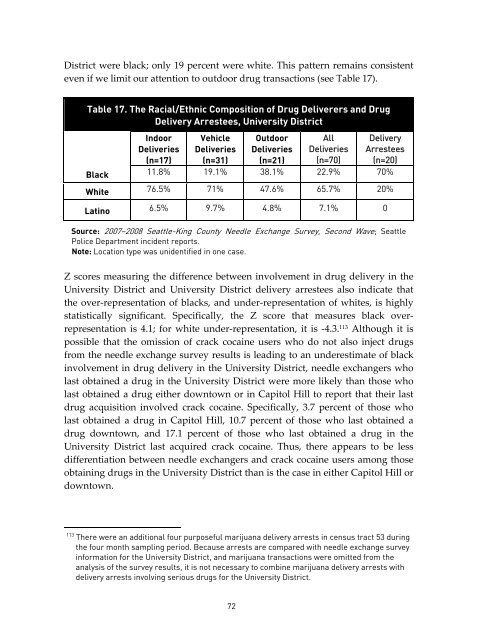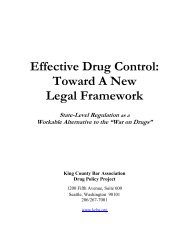RACE AND THE ENFORCEMENT OF DRUG DELIVERY LAWS IN ...
RACE AND THE ENFORCEMENT OF DRUG DELIVERY LAWS IN ...
RACE AND THE ENFORCEMENT OF DRUG DELIVERY LAWS IN ...
Create successful ePaper yourself
Turn your PDF publications into a flip-book with our unique Google optimized e-Paper software.
District were black; only 19 percent were white. This pattern remains consistent<br />
even if we limit our attention to outdoor drug transactions (see Table 17).<br />
Table 17. The Racial/Ethnic Composition of Drug Deliverers and Drug<br />
Delivery Arrestees, University District<br />
Indoor<br />
Deliveries<br />
(n=17)<br />
Vehicle<br />
Deliveries<br />
(n=31)<br />
Outdoor<br />
Deliveries<br />
(n=21)<br />
All<br />
Deliveries<br />
(n=70)<br />
Delivery<br />
Arrestees<br />
(n=20)<br />
Black 11.8% 19.1% 38.1% 22.9% 70%<br />
White 76.5% 71% 47.6% 65.7% 20%<br />
Latino 6.5% 9.7% 4.8% 7.1% 0<br />
Source: 2007–2008 Seattle-King County Needle Exchange Survey, Second Wave; Seattle<br />
Police Department incident reports.<br />
Note: Location type was unidentified in one case.<br />
Z scores measuring the difference between involvement in drug delivery in the<br />
University District and University District delivery arrestees also indicate that<br />
the over-representation of blacks, and under-representation of whites, is highly<br />
statistically significant. Specifically, the Z score that measures black overrepresentation<br />
is 4.1; for white under-representation, it is -4.3. 113 Although it is<br />
possible that the omission of crack cocaine users who do not also inject drugs<br />
from the needle exchange survey results is leading to an underestimate of black<br />
involvement in drug delivery in the University District, needle exchangers who<br />
last obtained a drug in the University District were more likely than those who<br />
last obtained a drug either downtown or in Capitol Hill to report that their last<br />
drug acquisition involved crack cocaine. Specifically, 3.7 percent of those who<br />
last obtained a drug in Capitol Hill, 10.7 percent of those who last obtained a<br />
drug downtown, and 17.1 percent of those who last obtained a drug in the<br />
University District last acquired crack cocaine. Thus, there appears to be less<br />
differentiation between needle exchangers and crack cocaine users among those<br />
obtaining drugs in the University District than is the case in either Capitol Hill or<br />
downtown.<br />
113<br />
There were an additional four purposeful marijuana delivery arrests in census tract 53 during<br />
the four month sampling period. Because arrests are compared with needle exchange survey<br />
information for the University District, and marijuana transactions were omitted from the<br />
analysis of the survey results, it is not necessary to combine marijuana delivery arrests with<br />
delivery arrests involving serious drugs for the University District.<br />
72

















